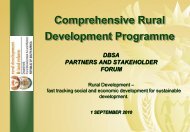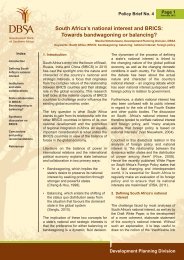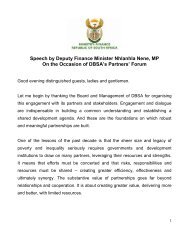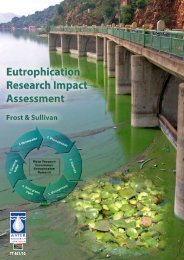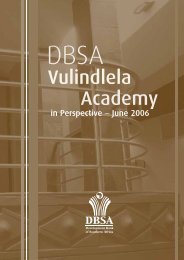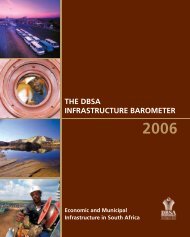The water Crisis in South Africa.pdf
The water Crisis in South Africa.pdf
The water Crisis in South Africa.pdf
Create successful ePaper yourself
Turn your PDF publications into a flip-book with our unique Google optimized e-Paper software.
14 th SANCIAHS SYMPOSIUM, 21-23 September 2009 CE Herold: <strong>The</strong> Water <strong>Crisis</strong> <strong>in</strong> <strong>South</strong> <strong>Africa</strong>Like it or not, we have already entered this unnerv<strong>in</strong>g marathon race, 10 years beh<strong>in</strong>d ourcompetitor. <strong>The</strong> question is, do we plod along uphill be<strong>in</strong>g dragged down by an ever<strong>in</strong>creas<strong>in</strong>g deficit and attendant risk of supply shortfall until 2019, or do we f<strong>in</strong>d a better way?Clearly up to now the LAs have failed miserably <strong>in</strong> deliver<strong>in</strong>g on the WDM and WC targets. Itcould also be argued that these targets should have been set while there was still time toimplement stop-gap supply side solutions (i.e. implement the next raw <strong>water</strong> resourcesscheme) and that the actual delivery should have been closely monitored and any deviationresponded to before the cut off date was reached. Here there may be a parallel with theenergy crisis. While some of these essential actions may have been called for, they werekept beh<strong>in</strong>d closed doors until we were already <strong>in</strong> deficit.<strong>The</strong> better way is to close the yawn<strong>in</strong>g gap between the supply strategy and the <strong>water</strong>demand growth by vigorously implement<strong>in</strong>g the targeted WDM and WC measures. <strong>The</strong>re isno other means left open to escape from further imperill<strong>in</strong>g the <strong>water</strong> supply to this criticallyimportant system.Indeed, most of the crises that we now face had their orig<strong>in</strong>s <strong>in</strong> poor management decisionstaken over the last decade or two.<strong>The</strong> Mgeni River system<strong>The</strong> Mgeni River system supplies <strong>water</strong> to the third largest economic region <strong>in</strong> <strong>South</strong> <strong>Africa</strong>.Two-thirds of the GNP of <strong>South</strong> <strong>Africa</strong> is accounted for by the Vaal and Mgeni River systemscomb<strong>in</strong>ed. Yet it has come to our attention that this region now only has a 92% assurednessof supply with about a 1 <strong>in</strong> 13 year risk of fac<strong>in</strong>g severe <strong>water</strong> restrictions.Figure 2 shows that the users of this system have been <strong>in</strong> a precarious deficit situation forthe last 4 years (more like 15 years, if it is considered that the rais<strong>in</strong>g of Midmar Dam,scheme MMTS-1, brought only fleet<strong>in</strong>g relief). Spr<strong>in</strong>g Grove Dam (Scheme MMTS-2) wasdue to have commenced stor<strong>in</strong>g <strong>water</strong> by the end of 2006. However, by late 2008 designwork on the dam had not yet commenced and the expected date of commission<strong>in</strong>g was 2012at the earliest.C:\Documents and Sett<strong>in</strong>gs\02569\My Documents\Articles\Institutional\<strong>water</strong> <strong>Crisis</strong> <strong>in</strong> Sa 708-paper C Herold.doc 511September 2009
14 th SANCIAHS SYMPOSIUM, 21-23 September 2009 CE Herold: <strong>The</strong> Water <strong>Crisis</strong> <strong>in</strong> <strong>South</strong> <strong>Africa</strong>Figure 2: Demand - supply curves for Mgeni River (diagram provided by Ethekw<strong>in</strong>i,October 2009)It must be stressed that even if commissioned <strong>in</strong> 2012, the proposed dam could play littlepart <strong>in</strong> a major drought until it has “warmed up” by substantially fill<strong>in</strong>g. Hence a period ofsevere risk of restrictions even deeper than shown <strong>in</strong> Figure 2 could extend well beyond2012. After commission<strong>in</strong>g of Spr<strong>in</strong>g Grove Dam the system would <strong>in</strong> any event rema<strong>in</strong> <strong>in</strong>deficit for a further 4 years until the end of 2017.<strong>The</strong> question must also be addressed as why the 6-year delay <strong>in</strong> the commission<strong>in</strong>g ofSpr<strong>in</strong>g Grove Dam has been allowed to happen?All of this po<strong>in</strong>ts to a national crisis unfold<strong>in</strong>g before our eyes, with severe disjo<strong>in</strong>t betweenthe plann<strong>in</strong>g by DWA, the LAs and the actual implementation.National Water Resource StrategyIt is a legal requirement for the M<strong>in</strong>ister to produce a National Water Resources Strategy(NWRS) every 5 years. <strong>The</strong> serious failures enumerated above clearly demonstrate that thisis not merely an adm<strong>in</strong>istrative chore. It is essential to the well be<strong>in</strong>g of our country.<strong>The</strong> NWRS must set out the key <strong>water</strong> challenges and proposed responses. <strong>The</strong> NWRS(2009/2014) is due out next year. <strong>The</strong>re must be wide consultation before this is f<strong>in</strong>alised.Where is it?WATER THEFTUnfortunately the beleaguered Vaal River system is subject to further depredation. A recentarticle on the Vaal River system, based on the f<strong>in</strong>d<strong>in</strong>gs of recent studies revealed: “irrigation<strong>water</strong> use <strong>in</strong> the Vaal River System has <strong>in</strong>creased by more than 100% between 1998 and2005 for the area upstream of Vaal Dam alone. … Up to 240 million m3/a of irrigation <strong>water</strong>use <strong>in</strong> the Upper Vaal WMA is estimated to be unlawful. ... This has been a shock<strong>in</strong>gdiscovery, and probably the ma<strong>in</strong> reason why the Vaal River System is currently <strong>in</strong> deficit.”(<strong>The</strong> Water Wheel May/June 2008). Comparisons have been drawn between the <strong>water</strong> theftand the yield of Mohali Dam, Phase 1b of the Lesotho Highlands Water Project (LHWP).<strong>The</strong> estimated <strong>water</strong> theft has s<strong>in</strong>ce been revised to 175 million m 3 /a, which rema<strong>in</strong>s a verysubstantial reduction <strong>in</strong> yield.As po<strong>in</strong>ted out earlier, the Vaal River system is already <strong>in</strong> deficit by about 2%. <strong>The</strong> <strong>water</strong>theft quadruples this to a very significant 8%. <strong>The</strong>re is thus no doubt whatsoever that thesystem is currently <strong>in</strong> deficit.It might have been expected that the <strong>water</strong> theft could have been remedied soon after be<strong>in</strong>gunearthed, simply by br<strong>in</strong>g<strong>in</strong>g the offenders to book. However, it turns out that the legal,adm<strong>in</strong>istrative and all important abstraction monitor<strong>in</strong>g mechanisms are not yet <strong>in</strong> place, 11years after the promulgation of the 1998 National Water Act. Hence, for fear of los<strong>in</strong>g a caseand the risk of sett<strong>in</strong>g an unfavourable legal precedent, it has been estimated that curb<strong>in</strong>gthe <strong>water</strong> theft could take up to 4 years. This is analogous to report<strong>in</strong>g a robbery <strong>in</strong> progressand be<strong>in</strong>g told to hang on because the police will take four years to arrive. In the meantime175 million m 3 of expensive imported <strong>water</strong> that urban consumers are pay<strong>in</strong>g dearly for isbe<strong>in</strong>g stolen <strong>in</strong> full view of the entire nation. It is ironical that if <strong>water</strong> restrictions areimplemented, the first to be affected will be the farmers themselves, <strong>in</strong>clud<strong>in</strong>g <strong>in</strong>nocentC:\Documents and Sett<strong>in</strong>gs\02569\My Documents\Articles\Institutional\<strong>water</strong> <strong>Crisis</strong> <strong>in</strong> Sa 708-paper C Herold.doc 611September 2009
14 th SANCIAHS SYMPOSIUM, 21-23 September 2009 CE Herold: <strong>The</strong> Water <strong>Crisis</strong> <strong>in</strong> <strong>South</strong> <strong>Africa</strong>parties located throughout the Vaal River system. Perhaps peer pressure could play a role <strong>in</strong>curb<strong>in</strong>g the theft?Aside from crim<strong>in</strong>al prosecution, perhaps we should consider simply bill<strong>in</strong>g the perpetratorsfor the full <strong>in</strong>cremental cost of the <strong>water</strong> that is be<strong>in</strong>g stolen? This would probably amount toaround R2 million per 50 ha centre pivot.It might be argued that the problem will not <strong>in</strong>fluence us if it takes 4 years to stop the theft,see<strong>in</strong>g as dur<strong>in</strong>g the 2008/9 season the major dams of the Vaal system filled. <strong>The</strong> state ofthe dams certa<strong>in</strong>ly does dim<strong>in</strong>ish the risk of short-term failure. However, we are <strong>in</strong> it for thelong haul. A critical drought sequence always starts with the dams full, with no further systemspillage until the drought is f<strong>in</strong>ally broken. Moreover, the onset of such a drought is neverknown <strong>in</strong> advance. Even a few years <strong>in</strong>to the drought, it is always possible that good ra<strong>in</strong>scould curtail the magnitude of the drought by fill<strong>in</strong>g and thereby re-sett<strong>in</strong>g the system.However, if the 2008/9 season was the start of a 1:50 or worse drought sequence, then wewould be enter<strong>in</strong>g it short of about 73 million m3/a stored <strong>in</strong> our dams (assum<strong>in</strong>g that the lastfill<strong>in</strong>g occurred towards the end of the last season). This figure would <strong>in</strong>crease by 1 million m 3every second day. Assum<strong>in</strong>g that 1 of the 4 years has already elapsed, we could be down by598 million m 3 , or 21% of the current annual demand, by the time the theft is halted. <strong>The</strong>sefigures are only illustrative, s<strong>in</strong>ce the loss would be modified somewhat by evaporation, butthey serve to illustrate the crisis that the <strong>water</strong> theft is plung<strong>in</strong>g our <strong>water</strong> security <strong>in</strong>to andhow seriously we should be tak<strong>in</strong>g it.It defies the imag<strong>in</strong>ation how the theft of 175 million m3/a could have gone undetected for solong. <strong>The</strong> same Water Wheel article states that the Polihali Dam scheme, (which will take atleast another decade to develop) will deliver a further 15 m3/s (i.e. 473 million m3/a). Thismeans that the current <strong>water</strong> theft <strong>in</strong> the Upper Vaal WMA alone is a whopp<strong>in</strong>g 37% of theentire delivery of the next major <strong>water</strong> augmentation scheme. How could operators andmanagers have missed such a large reduction (5.5 m 3 /s of base flow) <strong>in</strong> the amount of <strong>water</strong>reach<strong>in</strong>g Vaal Dam? This is <strong>in</strong>conceivable see<strong>in</strong>g as a new Crump weir was constructed onthe lower Liebenbergsvlei River at Frederiksdal <strong>in</strong> 1985 (12 years before the first phase ofthe LHWP was commissioned) with the express purpose of measur<strong>in</strong>g <strong>water</strong> losses of theLHWP? <strong>The</strong> hydrological records were available for the Ash River outfall, for this weir,Saulspoort Dam, two other <strong>in</strong>termediate po<strong>in</strong>ts on the Liebenbergsvlei River and furtherdownstream at Frankfort below the Wilge River confluence. <strong>The</strong> unwarranted proliferation ofirrigation activity would also have shown clearly <strong>in</strong> satellite imagery, to which DWA has fullaccess. In this regard there was already evidence of farmers purchas<strong>in</strong>g new centre pivotirrigation systems <strong>in</strong> anticipation of the LHWP. F<strong>in</strong>ally, regular ground <strong>in</strong>spections of the rivershould have revealed the multiplication of pumps.Unlike the preced<strong>in</strong>g crises <strong>in</strong> which LAs played a significant role, this one arises purely fromfailure to def<strong>in</strong>e <strong>water</strong> rights, enforce monitor<strong>in</strong>g, <strong>in</strong>terpret readily available <strong>in</strong>formation that iscollected at great cost and enforce compliance. Clearly it speaks of crumbl<strong>in</strong>g capacity with<strong>in</strong>DWA. This is evidence of another national crisis of immense proportions that is quietlyunfold<strong>in</strong>g and is discussed later <strong>in</strong> this article.DEMAND MANAGEMENT FAILURELocal Authorities<strong>The</strong> greater part of the mismatch between <strong>water</strong> supply and <strong>water</strong> demand is attributable tothe failure of LAs to deliver on WDM and WC targets.C:\Documents and Sett<strong>in</strong>gs\02569\My Documents\Articles\Institutional\<strong>water</strong> <strong>Crisis</strong> <strong>in</strong> Sa 708-paper C Herold.doc 711September 2009
14 th SANCIAHS SYMPOSIUM, 21-23 September 2009 CE Herold: <strong>The</strong> Water <strong>Crisis</strong> <strong>in</strong> <strong>South</strong> <strong>Africa</strong>Municipal <strong>water</strong> <strong>in</strong>frastructure, and especially buried pipe work has a reasonable service lifeof 50 years. This means that 2% of the capital works need to be replaced every year. Asthese works near the end of their service lives <strong>water</strong> leaks become more and more frequentand ma<strong>in</strong>tenance becomes more onerous. In addition, it is essential to cont<strong>in</strong>uously carry outma<strong>in</strong>tenance to deal with ongo<strong>in</strong>g leaks and other repairs. This is required to curtail <strong>water</strong>losses and ensure that the <strong>in</strong>tended service lives are atta<strong>in</strong>ed.Earlier DWA estimates <strong>in</strong>dicated that R600 million per year was needed between 2004/5 and2009/10 <strong>in</strong> Gauteng to redress the capital replacement backlog and to carry out regularma<strong>in</strong>tenance. Aga<strong>in</strong>st this, the 2008 WDM expenditure <strong>in</strong> Gauteng was only between R50and R100 million, which is only sufficient to cover 20% to 40% of the annual ma<strong>in</strong>tenancerequirement, without even touch<strong>in</strong>g the backlog. Moreover, dur<strong>in</strong>g this period the capitalreplacement backlog would have grown by 2% of the exist<strong>in</strong>g <strong>in</strong>frastructure per year,accru<strong>in</strong>g to a massive additional 10% of exist<strong>in</strong>g <strong>in</strong>frastructure. It is small wonder that the<strong>in</strong>frastructure leakage has reached crisis proportions and that municipalities are consistentlyfail<strong>in</strong>g to meet WDM targets.Figure 3 reveals a long history of the credibility gap between the planned and actuallyachieved demand reductions <strong>in</strong> the Umgeni River catchment. Comparison of the 2006demand projections made between 2000 and 2005 displays an almost exponentiallydim<strong>in</strong>ish<strong>in</strong>g expectation of mean<strong>in</strong>gful demand reductions be<strong>in</strong>g achieved, until the 2007projection (based on Figure 2) appears to reflect giv<strong>in</strong>g up of hope and acceptance of thestatus quo, presumably s<strong>in</strong>ce the demands have grown steadily s<strong>in</strong>ce 2001 with no apparentsign of abat<strong>in</strong>g.Figure 3: History of targeted and achieved Mgeni system demand reductionsUndue vacillation on the part of municipal decision makers appears to have played a majorrole <strong>in</strong> the failure to achieve WDM. Not only has this placed national <strong>water</strong> supply systems atC:\Documents and Sett<strong>in</strong>gs\02569\My Documents\Articles\Institutional\<strong>water</strong> <strong>Crisis</strong> <strong>in</strong> Sa 708-paper C Herold.doc 811September 2009
14 th SANCIAHS SYMPOSIUM, 21-23 September 2009 CE Herold: <strong>The</strong> Water <strong>Crisis</strong> <strong>in</strong> <strong>South</strong> <strong>Africa</strong>risk for years, it is also extremely short sighted given the large economic advantage to bega<strong>in</strong>ed from curtail<strong>in</strong>g the <strong>water</strong> losses.<strong>The</strong> DWA has called for the implementation of laudable measures to reduce the UmgeniDemand by 16% through curb<strong>in</strong>g <strong>water</strong> theft (8%) and replac<strong>in</strong>g broken asbestos cementpipes (8%). Thankfully some of these <strong>in</strong>itiatives are at last mov<strong>in</strong>g ahead. Further sav<strong>in</strong>gsshould accrue from the recycl<strong>in</strong>g of effluent that at present is runn<strong>in</strong>g to waste at sea. Whilethese <strong>in</strong>itiatives are costly and time consum<strong>in</strong>g (for example, R850 million over 3 years toreplace the old asbestos-cement pipes), they hold tremendous economic advantage s<strong>in</strong>cethe reduced <strong>water</strong> losses result <strong>in</strong> a short payback period. S<strong>in</strong>ce the dams are currently nearfull, the time frame of these actions may be short enough to significantly reduce, or evenelim<strong>in</strong>ate the exposure to unacceptable risk. But the curb<strong>in</strong>g of <strong>water</strong> theft and wastefulpractices and ongo<strong>in</strong>g essential ma<strong>in</strong>tenance and refurbishment will require endur<strong>in</strong>g politicalwill and the ongo<strong>in</strong>g employment of sufficient resources.ConsumersIt is important not to overlook the fact that much, perhaps up to half, of the <strong>water</strong> lossesoccur <strong>in</strong> the properties of consumers, whose pipe work and plumb<strong>in</strong>g fixtures are alsosubject to decay and the need for ma<strong>in</strong>tenance and replacement. This is particularlyapparent <strong>in</strong> areas where residents do not pay for their <strong>water</strong> and therefore treat it as a freegood and have no <strong>in</strong>centive to repair leaks. <strong>The</strong> <strong>in</strong>digent might also lack the means to affectthe necessary repairs.<strong>The</strong>re is thus an urgent need to educate users on the need to curtail leaks and to <strong>in</strong>stituteand susta<strong>in</strong> adequately funded programs to render plumb<strong>in</strong>g services <strong>in</strong> poorer areas.DECAYING INFRASTRUCTUREAge<strong>in</strong>g <strong>in</strong>frastructure affects both LAs and the DWA. <strong>The</strong>se are discussed below.Local AuthoritiesIn addition to the lack of achievement of WDM and ma<strong>in</strong>tenance targets by LAs, the collapseof <strong>water</strong> supply and sanitation <strong>in</strong>frastructure is well <strong>in</strong>to crisis mode <strong>in</strong> many, if not most, ruralareas.Bulk <strong>in</strong>frastructure<strong>The</strong> DWA‟s Strategic Framework on Water for Susta<strong>in</strong>able Growth and Developmentdiscussion document (April 2008) cites numerous cases where major <strong>water</strong> resources<strong>in</strong>frastructure is <strong>in</strong> serious need of ma<strong>in</strong>tenance and refurbishment. This <strong>in</strong>cludes “160 out of294 dams owned and operated by the department (54%) require ma<strong>in</strong>tenance to meetcurrent safety standards” and 17 canal schemes that require major rehabilitation work.Some of the pumps driv<strong>in</strong>g l<strong>in</strong>ks of the <strong>water</strong> transfer schemes to strategic <strong>in</strong>dustries havealso failed.In March it came to light that the outlet canal from Grootdraai Dam, which feeds <strong>water</strong> to thehighly strategic Sasol / Secunda complex and to some Eskom power stations is <strong>in</strong> adangerous state and urgently <strong>in</strong> need of refurbishment. <strong>The</strong> work has been held up by delays<strong>in</strong> the appo<strong>in</strong>tment of Professional Service Providers.Some of the feeder canals to the foot of the Tugela-Vaal <strong>water</strong> transfer scheme are also <strong>in</strong> astate if disrepair, reportedly with trees grow<strong>in</strong>g through them, and have apparently beenC:\Documents and Sett<strong>in</strong>gs\02569\My Documents\Articles\Institutional\<strong>water</strong> <strong>Crisis</strong> <strong>in</strong> Sa 708-paper C Herold.doc 911September 2009
14 th SANCIAHS SYMPOSIUM, 21-23 September 2009 CE Herold: <strong>The</strong> Water <strong>Crisis</strong> <strong>in</strong> <strong>South</strong> <strong>Africa</strong>partially abandoned. While this may be feasible dur<strong>in</strong>g wet conditions when other parts of thesystem can supply sufficient <strong>water</strong>, will this <strong>in</strong>frastructure be operative when we really need itdur<strong>in</strong>g times of drought?Midgley once described the Rhenosterspruit valley as <strong>South</strong> <strong>Africa</strong>‟s largest s<strong>in</strong>gle block ofirrigable soil, which could not be irrigated due to a shortage of <strong>water</strong>. While it is a relativelysmall scheme, reports have been received that the Koppies Dam outlet canal is now<strong>in</strong>operative.Information systemsTo measure is to know. However, grow<strong>in</strong>g gaps are evident <strong>in</strong> both flow and <strong>water</strong> qualitymonitor<strong>in</strong>g networks. <strong>The</strong> capacity to run associated <strong>in</strong>formation systems is also decl<strong>in</strong><strong>in</strong>g,with the result that threaten<strong>in</strong>g trends are not be<strong>in</strong>g identified, lead<strong>in</strong>g to <strong>in</strong>evitableconsequences such as the undetected theft of <strong>water</strong> from the Liebenbergsvlei and otherrivers <strong>in</strong> the Upper Vaal catchment. It is likely that there are other <strong>in</strong>cipient or even longstand<strong>in</strong>gproblems that are as yet undetected due to <strong>in</strong>adequate monitor<strong>in</strong>g and lack of theresources and capacity to <strong>in</strong>terpret the <strong>in</strong>formation and take appropriate remedial action.Fund<strong>in</strong>g deficit<strong>The</strong> Strategic Framework on Water for Susta<strong>in</strong>able Growth and Development discussiondocument <strong>in</strong>dicates a gross under provision of expenditure for the ma<strong>in</strong>tenance of <strong>water</strong>services assets.National Water Resources Infrastructure Agency (NWRIA)<strong>The</strong> new NWRIA (yet to be operational) is envisaged to handle the f<strong>in</strong>anc<strong>in</strong>g, constructionand management of major <strong>water</strong> resource works. Its establishment will see a phased<strong>in</strong>tegration of DWA‟s National Water Resources Infrastructure (NWRI) branch and the Trans-Caledon Tunnel Authority (TCTA). <strong>The</strong> NWRIA will raise <strong>in</strong>vestment funds on the capitalmarket, supplemented by the DWA budget where extra costs are envisaged for „social‟requirements. <strong>The</strong> NWRIA was <strong>in</strong>itially planned to be operational last year (2008) but it isnowhere near. Where is it?WATER QUALITY<strong>The</strong> challenge is not just quantity. Water that is too polluted to use is as serious as no <strong>water</strong>at all. This is beg<strong>in</strong>n<strong>in</strong>g to happen <strong>in</strong> some areas, to name but a few:Pollution problems <strong>in</strong>hibit<strong>in</strong>g <strong>water</strong> useVaal River CatchmentCoal and gold m<strong>in</strong><strong>in</strong>g and <strong>in</strong>dustrial pollution impairs <strong>water</strong> quality <strong>in</strong> the Waterval River.Large pollution sources <strong>in</strong> the small but highly developed Barrage catchment causesevere sal<strong>in</strong>ity, eutrophication and biological pollution, which <strong>in</strong> turn lead to hugeeconomic loss, necessitat<strong>in</strong>g blend<strong>in</strong>g and dilution operat<strong>in</strong>g rules that entail thedischarge of additional <strong>water</strong> from Vaal Dam.NW Prov<strong>in</strong>ce and Welkom / Virg<strong>in</strong>ia gold m<strong>in</strong><strong>in</strong>g decant (acid m<strong>in</strong>e dra<strong>in</strong>age) and sewageeffluent <strong>in</strong> the Middle Vaal WMA create similar problems.Salts are further concentrated <strong>in</strong> the Vaalharts irrigation scheme.C:\Documents and Sett<strong>in</strong>gs\02569\My Documents\Articles\Institutional\<strong>water</strong> <strong>Crisis</strong> <strong>in</strong> Sa 708-paper C Herold.doc 1011 September 2009
14 th SANCIAHS SYMPOSIUM, 21-23 September 2009 CE Herold: <strong>The</strong> Water <strong>Crisis</strong> <strong>in</strong> <strong>South</strong> <strong>Africa</strong>Intensive irrigation <strong>in</strong> the Modder-Riet catchment reduces the large quantity of fresh<strong>water</strong> imported from the Orange River to a trickle of highly sal<strong>in</strong>e <strong>water</strong> enter<strong>in</strong>g DouglasWeir.Polluted <strong>water</strong> spill<strong>in</strong>g from Douglas Weir contributes to the sal<strong>in</strong>ity of the downstreamOrange River.Crocodile WestMuch of the <strong>water</strong> resource of the upper Crocodile River catchment is derived from sal<strong>in</strong>eand nutrient enriched sewage effluent. This leads to sal<strong>in</strong>ity problems throughout thedownstream river system and severe eutrophication of the major impoundments. Severeeutrophication <strong>in</strong> Hartbeespoort Dam has persisted for decades, so much so that as earlyas the 1980s it was rejected as a source of raw <strong>water</strong> for Rustenburg <strong>in</strong> favour of a newpipel<strong>in</strong>e all the way from Rand Water.This could also affect <strong>water</strong> supply to the old and planned new power stations <strong>in</strong> theWaterberg area.Severe eutrophication led to the cancellation of an <strong>in</strong>ternational event at RoodeplaatDam.MpumalangaIntensive coal m<strong>in</strong><strong>in</strong>g <strong>in</strong> the upper Olifants River catchment has resulted <strong>in</strong> severesulphate and sal<strong>in</strong>ity problems.Sal<strong>in</strong>ity levels <strong>in</strong> the rema<strong>in</strong>der of the catchment are impaired by irrigation and m<strong>in</strong><strong>in</strong>g <strong>in</strong>the Phalaborwa area.Pollution has also been cited as a possible cause of crocodile kills <strong>in</strong> Loskop Dam and <strong>in</strong>the Kruger National Park.Mgeni and Durban beachesBiological pollution is a serious health threat <strong>in</strong> the Mgeni catchment and at variousbeaches.Atmospheric deposition<strong>The</strong> deposition of sulphate salts aris<strong>in</strong>g from emissions from power stations, Sasol andother <strong>in</strong>dustries has been recognised as a major long-term threat to the sal<strong>in</strong>ity andpossibly the acidity of the <strong>water</strong> resources of the Upper Vaal catchment. <strong>The</strong> potential forthese problems is viewed <strong>in</strong> so serious a light that it has become a consideration <strong>in</strong> thesit<strong>in</strong>g of future major power stations and consequently Eskom and Sasol are undertak<strong>in</strong>ga major study of these impacts.Biological health threat<strong>The</strong> preced<strong>in</strong>g pollution problems are serious enough to constitute crises <strong>in</strong> their own rights.However, the health threat posed by biological pollution is such an affront to the poor and<strong>in</strong>digent, who comprise so large a proportion of our population, that it warrants considerationon its own.C:\Documents and Sett<strong>in</strong>gs\02569\My Documents\Articles\Institutional\<strong>water</strong> <strong>Crisis</strong> <strong>in</strong> Sa 708-paper C Herold.doc 1111 September 2009
14 th SANCIAHS SYMPOSIUM, 21-23 September 2009 CE Herold: <strong>The</strong> Water <strong>Crisis</strong> <strong>in</strong> <strong>South</strong> <strong>Africa</strong>cont<strong>in</strong>ue externalis<strong>in</strong>g the costs of their production to the detriment of downstream users andthe environment.Why has the WDCS not yet been implemented?CAPACITY AND SKILLS<strong>The</strong> loss of capacity and skills is one of the ma<strong>in</strong> reasons why the National Water Act (NWA)is not be<strong>in</strong>g implemented successfully.Local AuthoritiesOver the last 15 years LAs have experienced a 7-fold loss of eng<strong>in</strong>eers and technologists.This has <strong>in</strong>evitably resulted <strong>in</strong>:<strong>The</strong> collapse of <strong>in</strong>frastructure and ma<strong>in</strong>tenance programmesWidespread demand management failuresWater treatment failure.This is a major national crisis that threatens the life-blood of the country.Middle management gapDWA has an essentially technical function, which has need of 250 eng<strong>in</strong>eer<strong>in</strong>g posts. Ofthese only 39% were filled last year.Over a number of years a gap has been open<strong>in</strong>g <strong>in</strong> the middle management ranks of theDWA. This widen<strong>in</strong>g has accelerated and now extends <strong>in</strong>to metros and Water Boards. <strong>The</strong>seorganisations have a core of experienced senior managers who are barely cop<strong>in</strong>g.<strong>The</strong> gravity of the situation is illustrated by the fact that last year DWA grades 8 and 9, whichshould be entered by graduate eng<strong>in</strong>eers who have completed their professional tra<strong>in</strong><strong>in</strong>g,had only 6 out of 45 posts filled. On the other side of the middle management chasm, 47% ofthe skilled staff will retire with<strong>in</strong> 10 years, represent<strong>in</strong>g a catastrophic haemorrhag<strong>in</strong>g of<strong>in</strong>stitutional memory.<strong>The</strong> problem orig<strong>in</strong>ates from the <strong>in</strong>ability to reta<strong>in</strong> new staff <strong>in</strong>ducted <strong>in</strong>to the organisations.Recruitment of young professionals comes ma<strong>in</strong>ly from bursary students who leave theorganisation soon after work<strong>in</strong>g off their bursary obligations, by which time they have barelybegun to be effective even <strong>in</strong> the lower levels of the organisation. Few stay long enough toga<strong>in</strong> mean<strong>in</strong>gful experience and advance through the organisation. This opens up a widen<strong>in</strong>gmiddle management gap that starves the organisation of skilled manpower. This has anegative feedback, s<strong>in</strong>ce the few experienced managers who are left have less time to givethe necessary tra<strong>in</strong><strong>in</strong>g to their protégés. Most of these leave anyway, s<strong>in</strong>ce the professionalsalary scales at the lower end of the organisation are hopelessly <strong>in</strong>adequate compared withwhat can be earned <strong>in</strong> the consult<strong>in</strong>g and contract<strong>in</strong>g fields, both of which are activelyrecruit<strong>in</strong>g.It is expected that many of the experienced senior managers would tend to stay with theDepartment longer than the junior recruits s<strong>in</strong>ce they have better salaries, hold responsiblepositions, derive a high level of job satisfaction, are dedicated to their work and tend to holdout for their retirement benefits. However, they are becom<strong>in</strong>g <strong>in</strong>creas<strong>in</strong>gly stressed as themagnitude of the problems fac<strong>in</strong>g them magnify while at the same time their numbersdim<strong>in</strong>ish due to retirement and resignation. Pressure of work is also mak<strong>in</strong>g them<strong>in</strong>creas<strong>in</strong>gly <strong>in</strong>accessible, which carries <strong>in</strong>herent dangers.C:\Documents and Sett<strong>in</strong>gs\02569\My Documents\Articles\Institutional\<strong>water</strong> <strong>Crisis</strong> <strong>in</strong> Sa 708-paper C Herold.doc 1311 September 2009
14 th SANCIAHS SYMPOSIUM, 21-23 September 2009 CE Herold: <strong>The</strong> Water <strong>Crisis</strong> <strong>in</strong> <strong>South</strong> <strong>Africa</strong>Figure 4: Water professional tra<strong>in</strong><strong>in</strong>g pipel<strong>in</strong>eAside from the allure of easy access to higher symbols, maths literacy is often promotedbecause of a lack of competent core maths teachers.As implemented, the advent of core maths as a replacement for higher grade maths is afurther setback. This is because geometry has been excised from the ma<strong>in</strong>stream and hasbecome an optional third maths paper, for which the students ga<strong>in</strong> no additional recognition.A further dis<strong>in</strong>centive is that this additional paper has been rendered more difficult by add<strong>in</strong>gmost of the contents of applied maths, which used to be a separate fully accredited subject.Dropp<strong>in</strong>g geometry appears to be little more than a th<strong>in</strong>ly disguised cover for the lack ofadequately tra<strong>in</strong>ed maths teachers. Moreover, most schools do not even offer tuition for the3 rd maths paper. Three dimensional perception and geometry are essential features ofeng<strong>in</strong>eer<strong>in</strong>g. <strong>The</strong>ir exclusion is perhaps ak<strong>in</strong> to submitt<strong>in</strong>g to surgery by a doctor who lacksdepth perception.To make matters worse, the first crop of new matriculants pass<strong>in</strong>g through the new educationsystem at the end of 2008 displayed a huge <strong>in</strong>crease <strong>in</strong> maths grades, which was totallyunsupported by a similar rise <strong>in</strong> science competence, the two of which have been closelyl<strong>in</strong>ked <strong>in</strong> the past. It has been suggested by competent analysts that the grades may havebeen artificially <strong>in</strong>flated by up to 25%. This means that a student who <strong>in</strong> the past would havereceived 35% would now fulfil the m<strong>in</strong>imum 60% requirement for admission to theeng<strong>in</strong>eer<strong>in</strong>g faculties of many universities. Without exception, universities were surprised bythe phenomenal upsurge <strong>in</strong> the number of applicants who fulfilled the matriculationrequirements for entry <strong>in</strong>to eng<strong>in</strong>eer<strong>in</strong>g faculties. For example, grade creep forced the CivilEng<strong>in</strong>eer<strong>in</strong>g faculty of Wits University to accept 270 first year students, when they wereC:\Documents and Sett<strong>in</strong>gs\02569\My Documents\Articles\Institutional\<strong>water</strong> <strong>Crisis</strong> <strong>in</strong> Sa 708-paper C Herold.doc 1511 September 2009
14 th SANCIAHS SYMPOSIUM, 21-23 September 2009 CE Herold: <strong>The</strong> Water <strong>Crisis</strong> <strong>in</strong> <strong>South</strong> <strong>Africa</strong>expect<strong>in</strong>g only 100. <strong>The</strong>re was always the remote possibility that the upsurge might besymptomatic of a greater proportion of the available pool of students choos<strong>in</strong>g eng<strong>in</strong>eer<strong>in</strong>gbecause of the publicity surround<strong>in</strong>g the construction of new stadiums and the Gautra<strong>in</strong>. Alasthis was not to be, and the first semester results showed very high first year failure rates,confirm<strong>in</strong>g the worst fears regard<strong>in</strong>g grade creep.<strong>The</strong> previous government attempted to get the top 5% of the professionals out of only 10% ofthe population, which was a genetic impossibility. As a result of this deliberate policy therewere enough professionals to extend adequate services to only a small portion of thepopulation. By now we should have been <strong>in</strong> a position to draw on a much larger pool ofprofessionals approach<strong>in</strong>g 10 times the previous size. However, the situation has now arisenwhere all of our share of eng<strong>in</strong>eer<strong>in</strong>g and scientific professionals have to be drawn from only5% of 5% of the population, which is only half of what we had before. This has not been done<strong>in</strong>tentionally for political ga<strong>in</strong>. But the results are devastat<strong>in</strong>g.One of the consequences of the failure of the education system has been to set back theatta<strong>in</strong>ment of HDI goals among eng<strong>in</strong>eer<strong>in</strong>g and science professions by decades. <strong>The</strong> schoolsystem is starv<strong>in</strong>g universities of HDIs with the required skills to enter eng<strong>in</strong>eer<strong>in</strong>g, scientificand other technically demand<strong>in</strong>g faculties, and successfully complete their degrees. It is notfor want of ability. 95% of the talent is simply be<strong>in</strong>g lost to eng<strong>in</strong>eer<strong>in</strong>g and sciences – victimsof <strong>in</strong>adequate maths and science tra<strong>in</strong><strong>in</strong>g.Far from fix<strong>in</strong>g the problem, the front page headl<strong>in</strong>e of last week‟s Sunday Times read: “Planto dumb down matric” with the sub head<strong>in</strong>g: “Department proposes that requirement fordist<strong>in</strong>ction be lowered from 80% to 70%” (Sunday Times, 13 September 2009). Hopefully thisis a throw back to the previous regime and this proposal will be rejected.Education is a national disaster of monumental proportions.Obviously not all of the few university recruits with the necessary skills will chooseeng<strong>in</strong>eer<strong>in</strong>g and science career paths, and fewer still will lean towards the <strong>water</strong> field. Somewill drop out of university, leav<strong>in</strong>g only a trickle enter<strong>in</strong>g the <strong>water</strong> field.Even if it takes only two years to revamp the maths education <strong>in</strong> our secondary schools(which is unlikely to suffice, s<strong>in</strong>ce the essential feedstock of good maths teachers has to bebuilt up), it would still take 12 years before an appreciable effect is felt at the end of theprofessional pipel<strong>in</strong>e. (Five years <strong>in</strong> secondary school, four years at university and anotherthree years of on the job professional tra<strong>in</strong><strong>in</strong>g.) And even then they would still have a longway to go <strong>in</strong> ga<strong>in</strong><strong>in</strong>g sufficient experience.CLIMATE CHANGECompared with the man-made crises that we are fac<strong>in</strong>g, climate change is still a much lessimm<strong>in</strong>ent threat. However, it has been suggested that the impact of global warm<strong>in</strong>g would beamplified <strong>in</strong> the <strong>water</strong> environment with greater variability reflected <strong>in</strong> bigger and morefrequent floods and longer droughts. To date there has been no evidence of this <strong>in</strong> our localhydrological records, but if it should occur it would <strong>in</strong>crease the challenge of manag<strong>in</strong>g ourprecious <strong>water</strong> resources. <strong>The</strong> much bigger man-made threats that have been po<strong>in</strong>ted out <strong>in</strong>the preced<strong>in</strong>g sections will simply be overlaid with a higher risk of system failure and theneed to plan that much more effectively.<strong>The</strong>refore, if we are concerned about manag<strong>in</strong>g the impacts of climate change and adapt<strong>in</strong>gto them, it is vitally important that we should strengthen, not weaken, our capacity to manageour <strong>water</strong> resources.C:\Documents and Sett<strong>in</strong>gs\02569\My Documents\Articles\Institutional\<strong>water</strong> <strong>Crisis</strong> <strong>in</strong> Sa 708-paper C Herold.doc 1611 September 2009
14 th SANCIAHS SYMPOSIUM, 21-23 September 2009 CE Herold: <strong>The</strong> Water <strong>Crisis</strong> <strong>in</strong> <strong>South</strong> <strong>Africa</strong>CONCLUSIONIt is clear that on a number of fronts the <strong>water</strong> sector is already fac<strong>in</strong>g crises of nationalimportance. If left unattended they will have catastrophic consequences. However, even atthis stage all of them can and must be managed. Government is well aware of the problemsand is tak<strong>in</strong>g steps to rectify them, especially the crises with<strong>in</strong> Local Government. We musthelp them to succeed.REMEDIATION<strong>The</strong> follow<strong>in</strong>g issues have to be addressed as matters of great national urgency:Supply side provisionIt is essential to ensure that phase 2 of the LHWP proceeds on schedule and that Spr<strong>in</strong>gGrove Dam is expedited.Eradication of <strong>water</strong> theftNo effort should be spared <strong>in</strong> speed<strong>in</strong>g up the eradication of the <strong>water</strong> theft <strong>in</strong> the Upper VaalRiver catchment. Use of the media should not be discounted, plus enlist<strong>in</strong>g the op<strong>in</strong>ion ofother framers who would be adversely affected by <strong>water</strong> restrictions. Consideration shouldalso be given to mak<strong>in</strong>g civil cases aga<strong>in</strong>st recalcitrant farmers to sue for damages torecover the full cost of the <strong>water</strong> theft.Accelerate WDM / WC <strong>in</strong>itiatives<strong>The</strong> great urgency to get demand management <strong>in</strong>itiatives operational cannot be over stated.It is understood that large sums of money have been allocated for this purpose. This isnecessary to deal with the ma<strong>in</strong>tenance and refurbishment backlogs. This needs to beallocated wisely at the local level and translated <strong>in</strong>to rapid delivery. This will require fullcooperation from decision makers <strong>in</strong> the LAs. Moreover <strong>water</strong> revenues need to be strictlyr<strong>in</strong>g-fenced to ensure that <strong>in</strong> the future sufficient allocation is made to fund the all importantrout<strong>in</strong>e ma<strong>in</strong>tenance and refurbishment programmes.Build capacity <strong>in</strong> Local Authorities<strong>The</strong>re is an urgent need to build capacity at every level <strong>in</strong> local authorities and ensure thatthe WDSPs are produced <strong>in</strong> time, the <strong>water</strong> supply <strong>in</strong>frastructure is ma<strong>in</strong>ta<strong>in</strong>ed andrefurbished and that household <strong>water</strong> leakage and <strong>water</strong> theft is curbed. This will requireactive recruit<strong>in</strong>g and substantial improvement <strong>in</strong> service conditions, <strong>in</strong>clud<strong>in</strong>g attractivesalaries and sufficient status to affect the decision mak<strong>in</strong>g process.Build capacity <strong>in</strong> DWA<strong>The</strong>re is an urgent need to improve service conditions for professional eng<strong>in</strong>eers andscientists <strong>in</strong> DWA to save the organisation from crippl<strong>in</strong>g loss of essential middle and topmanagement skills. It is essential to make salary scales and service conditions attractive atevery level, especially at the entry level. A doubl<strong>in</strong>g of salaries at the entry level might beappropriate. Clear growth paths need to be established for all competent personnel.Refurbish and ma<strong>in</strong>ta<strong>in</strong> ag<strong>in</strong>g bulk <strong>water</strong> <strong>in</strong>frastructureProgrammes for the systematic ma<strong>in</strong>tenance of bulk <strong>water</strong> <strong>in</strong>frastructure should beestablished and the necessary fund<strong>in</strong>g secured.C:\Documents and Sett<strong>in</strong>gs\02569\My Documents\Articles\Institutional\<strong>water</strong> <strong>Crisis</strong> <strong>in</strong> Sa 708-paper C Herold.doc 1711 September 2009
14 th SANCIAHS SYMPOSIUM, 21-23 September 2009 CE Herold: <strong>The</strong> Water <strong>Crisis</strong> <strong>in</strong> <strong>South</strong> <strong>Africa</strong>Strengthen l<strong>in</strong>k between <strong>water</strong> resource and <strong>water</strong> demand managementFoster effective l<strong>in</strong>kage between the WDSPs and the NWRS to ensure the development ofcoord<strong>in</strong>ated plans and effective implementation.Flow monitor<strong>in</strong>g and feedbackRebuild the capacity to run and <strong>in</strong>terpret flow monitor<strong>in</strong>g systems to ensure that future theftof the resource is identified and dealt with timeously.Establish Waste Discharge Charge System<strong>The</strong> Waste Discharge Charge System should be established as soon as possible, but bekept simple to implement and manage.Implement effective sanitationEvery effort should be made to establish effective sanitation systems <strong>in</strong> all LAs and toempower proper management. This requires the complete buy-<strong>in</strong> of local politicians, strictcontrol of fund<strong>in</strong>g and transparent accountability and may require the removal of <strong>in</strong>effectiveor corrupt managers. Central monitor<strong>in</strong>g and public feedback, such as the blue drop andgreen drop accreditation are valuable moves <strong>in</strong> this regard.Revamp maths and science educationEvery effort should be made to impress on the Department of Education the damage thatthey are <strong>in</strong>flict<strong>in</strong>g on the economy and the urgent need to overhaul maths education <strong>in</strong>secondary schools with a view to utilis<strong>in</strong>g the full potential of learners.Short-sighted policies that promote “grade creep” and engender glar<strong>in</strong>g gaps <strong>in</strong> the<strong>in</strong>complete preparation of university candidates are a major disservice to the studentsthemselves and to the community that they aspire to help.It is essential to raise the bar for teachers to ensure the necessary improvement <strong>in</strong> educationstandards. <strong>The</strong> remuneration of good maths and science teachers should be radically<strong>in</strong>creased. However, to be fully effective this should be accompanied by the discipl<strong>in</strong><strong>in</strong>g andeven dismissal of lazy and <strong>in</strong>competent teachers.Good quality career guidance should be provided, at least from grade 9, to ensure thatscholars can make properly <strong>in</strong>formed choices of matric subjects.Open up and collaborateIn view of the fact that capacity is currently <strong>in</strong> a critical condition and the length of timerequired to rebuild it, it is essential to use the human resources at our disposal to their fullestpotential.<strong>The</strong> imperative for transparency <strong>in</strong> DWA cannot be over stated. <strong>The</strong> public has the right toknow about the decisions that affect their and their children‟s future.<strong>The</strong> private sector has a large reservoir of desperately needed professional expertise andtechnical skills that can and must be tapped to their full potential. In this regard SAICE andWISA have taken several <strong>in</strong>itiatives to assist and their members are ready to do much more.Initiatives already underway <strong>in</strong>clude:C:\Documents and Sett<strong>in</strong>gs\02569\My Documents\Articles\Institutional\<strong>water</strong> <strong>Crisis</strong> <strong>in</strong> Sa 708-paper C Herold.doc 1811 September 2009
14 th SANCIAHS SYMPOSIUM, 21-23 September 2009 CE Herold: <strong>The</strong> Water <strong>Crisis</strong> <strong>in</strong> <strong>South</strong> <strong>Africa</strong>SAICE set up a Section 21 company devoted to address<strong>in</strong>g skills shortages, particularly<strong>in</strong> Local Authorities.<strong>The</strong> spirit of cooperation is evidenced by the fact that DWA was a co-funder of theENERGYS programme and they are currently fund<strong>in</strong>g several capacity build<strong>in</strong>gprogrammes through WISA and SAICE.SAICE pioneered a meet<strong>in</strong>g of Tertiary Institutions to discuss bottlenecks and maderepresentations to the Department of Education. <strong>The</strong> SAICE Section 21 Company wassubsequently appo<strong>in</strong>ted by JPSA to submit a report and make recommendations on howto deal with this issue.PrioritiseGiven the capacity constra<strong>in</strong>ts, DWA should focus on the priorities, not on “nice to haves”.Programme<strong>The</strong> NWA does not require everyth<strong>in</strong>g to be done at once.SimplifySome parts of the NWA, and particularly the ensu<strong>in</strong>g regulations, are too complex and needto be simplified to be feasible and to avoid divert<strong>in</strong>g scarce resources.Partner<strong>South</strong> <strong>Africa</strong> still has many highly regarded skills <strong>in</strong> the <strong>water</strong> sector. <strong>The</strong>y must beharnessed and fully used.FINAL REMARKSF<strong>in</strong>ally, we would all do well to heed the follow<strong>in</strong>g words of wisdom:“<strong>The</strong> prudent see danger and take refuge, but the simple keep on go<strong>in</strong>g and suffer for it.”Proverbs 27:12C:\Documents and Sett<strong>in</strong>gs\02569\My Documents\Articles\Institutional\<strong>water</strong> <strong>Crisis</strong> <strong>in</strong> Sa 708-paper C Herold.doc 1911 September 2009





